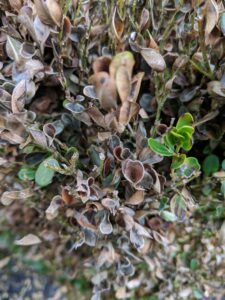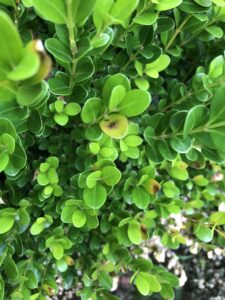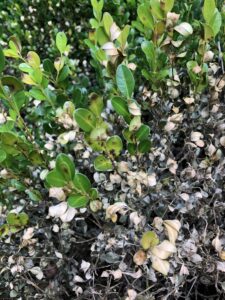Table of Contents
ToggleLast Updated on April 18, 2025
Relatively new to New Jersey, the destructive disease boxwood blight can cause substantial damage to Boxwood plants. Because boxwoods are commonly used in landscapes in our area, this disease has the potential to be widespread across many landscapes. First identified in the United States in October 2011, the disease made its way to New Jersey two years later. Although the name would allude to this disease only impacting boxwoods, this disease also affects pachysandra and sarcococca varieties. In this blog we discuss the cause and favorable conditions of the disease, how it spreads, what the disease looks like on boxwoods, and finally prevention and boxwood blight treatment.
Technically, the disease is caused by the fungus Calonectria pseudonaviculata and symptoms of the disease becomes evident in the middle to late summer. This pathogen requires warm humid conditions, ideally over 68 degrees, to grow and spread. With the weather patterns that we experience in New Jersey, late May through late September typically provides the warm humid weather suitable for boxwood blight. Additionally, this disease progresses very quickly as a boxwood plant can go from the beginning stages of infection, to having leaves defoliate within one week, if conditions are conducive to disease growth.
How it spreads
How does this devastating boxwood disease spread? The spores produced by the pathogen are sticky in texture and cling to most surfaces that encounter the fungus; pruning tools, vehicles, shipping containers, shoes, clothes and even animals. The disease can also be transported by wind, rain and irrigation water.
Identifying the Disease
Boxwood blight symptoms includes light to dark circles on the leaves of the newest foliage and typically start at the base of the plant and move upward. Over time the spots grow and coalesce with other areas, quickly turning the whole leaf brown. The lesions, or brown spots, can lead to death and leaf drop of the infected areas. Other characteristics of the boxwood disease include dark streaks on the twigs and white structures on the underside of the leaves. In the images below, you can see the early stages of the disease with the picture on the left, and the devastating impact it has on a boxwood as the disease spreads with the picture on the right.
Prevention and Control
What can you do once boxwood blight has been identified in your landscape? Eliminating the fungus on plants that are infected is not possible and controlling the pathogen in the soil is very difficult. Unfortunately, the best thing to do is remove the diseased plant(s) from your landscape to stop the further spreading to surrounding boxwoods. It is important to note that the removal of diseased boxwoods and leaf debris does not eradicate the pathogen alone. The pathogen has been detected in soil for five to six years after removal of the plant, and potentially even longer.
Often times when dealing with a disease in a plant, a fungicide can be applied to suppress the disease, which would allow the plant to continue to grow without the spread of the disease for a number of days. Fungicides can also be used as a preventative measure to attempt to keep healthy tissue from being infected. Unfortunately for boxwood blight, the research has shown limited control even when fungicides are perfectly applied to protect boxwoods that have not yet been infected in an area where the disease is present. The fungicides also have no control in curing a boxwood if the disease is already present.
Ultimately, the best recommendation is the removal of infected boxwoods, fallen debris and surrounding soil and mulch, and to replace with a completely different plant that is not susceptible to boxwood blight. The University of Georgia put together a recommendation of various plants that could be a substitute for boxwood(s) in your landscape; some plants include, pieris, junipers, rhododendron, and euonymus.
Other Boxwood issues
If you are experiencing issues with your boxwood plants, and boxwood blight is not the obvious suspect, another common issues in our area is leafminer on boxwoods. For more information on the damage caused by leafminer insects, check out our blog.
Conclusion
Boxwood blight has proven to be destructive in our area when weather conditions are favorable. With a disease that does not have a cure and rapidly spreads, control and prevention of the disease has been difficult. If you are in our service area and suspect that boxwood blight is found on your landscape please call our office or request a free estimate to talk to a knowledgeable professional about your options.




